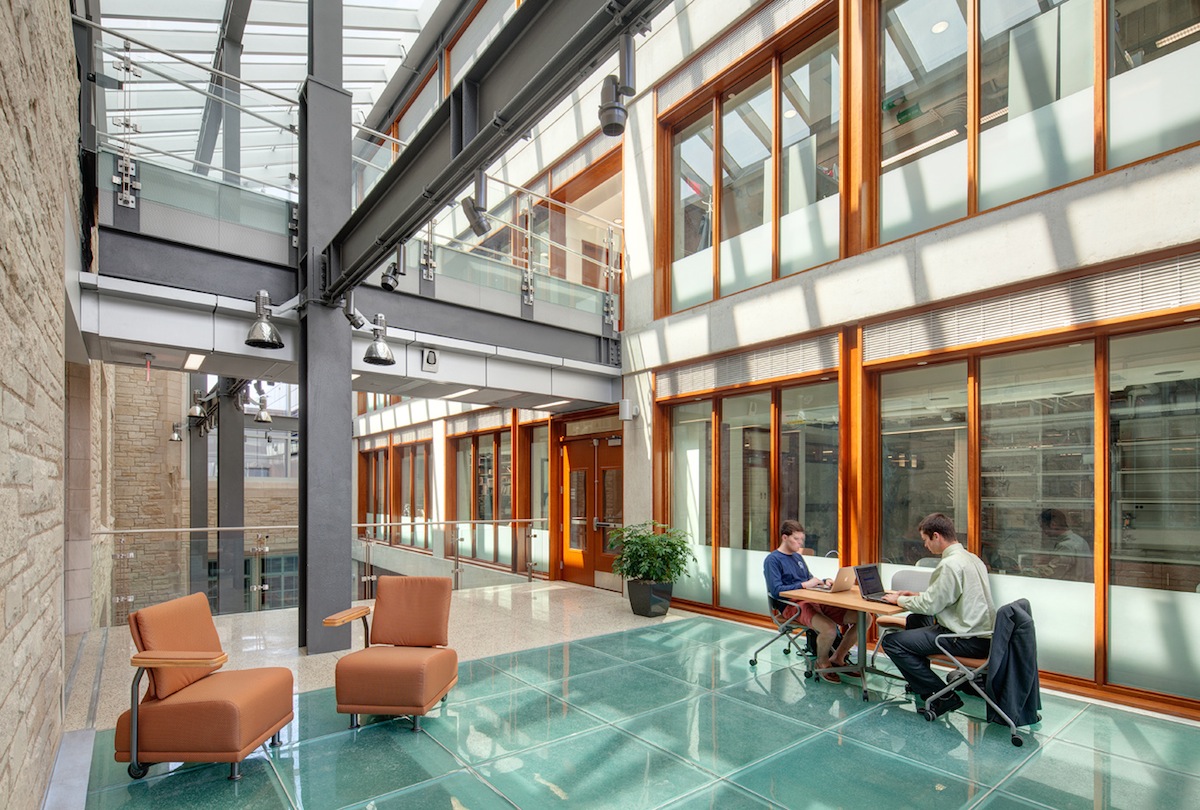Project: Northwestern University Engineering Life Sciences
Location: Evanston, Ill.
Architect: Flad Architects
Glazing Contractor: Mid-States Glass and Metal, Inc.
Glazing System Supplier: Technical Glass Products
Glass Style: Fireframes ClearFloor® Fire-Rated Glass Floor System
In implementing Northwestern University’s Engineering Life Sciences infill design, Flad Architects faced the challenge of ensuring adequate, balanced light given the adjacent, existing building wings. This was particularly important in the nuclear magnetic resonance lab and other ground floor areas, as too much direct sunlight could harm specialized instruments.
To allow for light penetration from the fifth floor to the ground floor, the design team desired a large, central atrium. One potential setback with drawing light through the atrium was meeting fire and life safety codes. The firm needed a code-approved floor to divide the shaft into two segments, and to provide a barrier to fire and chemicals in the case of an accident. However, many of the floor systems available to meet these stringent fire and life safety codes were opaque fire-stopping materials such as concrete and corrugated steel.
To satisfy fire and life safety codes and help illuminate the infill, the design team used a fire-rated glass floor system developed by Technical Glass Products (TGP). The Fireframes ClearFloor® System consists of two-hour fire-rated Pilkington Pyrostop® heat barrier glass; a tempered, laminated walking surface glass; and a steel framing grid. It is fire-rated for two hours and provides a barrier to flames and smoke, as well as radiant and conductive heat.
“We needed a fire barrier in the atrium, but we didn’t want researchers and students to be in the dark,” says Garrett. “The fire-rated glass floor system allowed us to compartmentalize a very large volume of space without blocking off access to daylight.”

Fire-rated glass floor system doubles as light well. Photo: courtesy TGP
The fire-rated glass floor system supports loads up to 150 psf (732 kg/m2), which creates additional usable space in the project. The system’s textured, top-surface glass provides students and faculty with the necessary traction to walk across its surface without slipping. The use of ceramic etched laminated glass creates a mild opacity that allows the system to diffuse daylight from above the atrium down into the nuclear magnetic resonance ground-floor lab.
“Direct sunlight could damage the highly specialized instruments in the nuclear magnetic resonance lab,” says Garrett. “The pattern on the fire-rated glass floor system creates just enough opacity to allow for the transfer of soft, even light.”
Today, students studying on the fire-rated glass floor system can see the shape of instruments in the lab below. At the same time, the translucent glass provides privacy from ground-floor occupants looking up towards the light well above.
“It’s great to see the students are comfortable on the fire-rated glass floor. They have no hesitation to spend time studying on it,” adds Garrett.
For more information on the Fireframes ClearFloor System, along with TGP’s other specialty architectural glass and framing, visit www.fireglass.com.
Technical Glass Products
800.426.0279
800.451.9857 – fax
sales@fireglass.com
www.fireglass.com
Related Stories
| Aug 11, 2010
World's tallest all-wood residential structure opens in London
At nine stories, the Stadthaus apartment complex in East London is the world’s tallest residential structure constructed entirely in timber and one of the tallest all-wood buildings on the planet. The tower’s structural system consists of cross-laminated timber (CLT) panels pieced together to form load-bearing walls and floors. Even the elevator and stair shafts are constructed of prefabricated CLT.
| Aug 11, 2010
Platinum Award: The Handmade Building
When Milwaukee's City Hall was completed in 1896, it was, at 394 feet in height, the third-tallest structure in the United States. Designed by Henry C. Koch, it was a statement of civic pride and a monument to Milwaukee's German heritage. It was placed on the National Register of Historic Places in 1973 and designated a National Historic Landmark in 2005.
| Aug 11, 2010
Special Recognition: Kingswood School Bloomfield Hills, Mich.
Kingswood School is perhaps the best example of Eliel Saarinen's work in North America. Designed in 1930 by the Finnish-born architect, the building was inspired by Frank Lloyd Wright's Prairie Style, with wide overhanging hipped roofs, long horizontal bands of windows, decorative leaded glass doors, and asymmetrical massing of elements.







